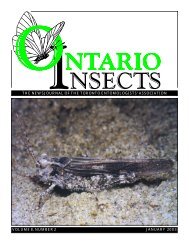1995 - Toronto Entomologists' Association
1995 - Toronto Entomologists' Association
1995 - Toronto Entomologists' Association
Create successful ePaper yourself
Turn your PDF publications into a flip-book with our unique Google optimized e-Paper software.
Ontario InsectsNotes on Behaviour of a European Earwig (Forficula auricularia)Everyone knows earwigs. Most peopledon't have much use for them. Someare definite pests of small seedlings, butoverall they tend not to be pests of cropsor plants in general. In fact some speciesare predacious and play a role incontrolling mites and aphids. I wouldsay that it is the fact they just get intoevery nook and cranny that makes themirritating. It is probably this characteristicthat initiated the belief that the earwigwould climb into people's ears.In July of 1994 I observed another littleknown defensive behaviour in the earwig.A mature earwig was observed carryingan adult house spider (Acharaneatepidariorum). The earwig was using itscerci and had caught the spider betweenthe abdomen and its cephalothorax. Asthe spiders legs were facing upwards, itwas unable to gain any purchase or gripand was thus defenceless.I am unsure of the events that lead tothis observation. I can only assume thatthe earwig had blundered into the spi-ders web. The spider had reacted byattacking the earwig. In this case thespider would have come down the weband then attempted to subdue the earwigby throwing silk at it to restrict thepreys movement. The earwig in responsewould have lifted its abdomenover its head and closed its cerci aroundthe spider. In the struggle that followed,the spider must have lost its grip allowingthe earwig to escape. The result wasthe trapped spider.I do not know how long the earwigwould hold the spider in this manner,but it was certainly long enough for thespider to give up its attempt at prey capture.Although I had been pinched byearwigs, I had never seen or heard ofthese cerci being of any real use. Theobservation was therefore a surprise. Inall references that I have subsequentlylooked up, I have only come across oneother comment on a similar behaviour.Swan & Papp (1972) report the cerciwere used against ants that attackedRearing the Black Swallowtail (papiliopolyxenes asterias) in York CountyThe female of this common speciesseems to readily lay its eggs. Early inAugust 1994, one layed eggs on a carrotwithin two days ofplacing it on the plantunder a plastic bag and coathanger tentto prevent escape. About six days later,approximately half of the eggs hatched.At first, the larvae didn't eat much andunfortunately, only one survived - itseems that the reason may be that somewere midgets (maybe because some didnot eat their eggshells). By August 18,when the larva was in about its thirdinstar, I found a full grown polyxeneslarva on dill, which I took home as aspecimen to aid in a specimen diagramof the life cycle of the black swallowtail.I later found another, which I took intocaptivity, and reared to the pupal stage.It pupated on the 29th of August. I thenLarva of the BlackSwallowtailset it in my diagram,completingit. As for the survivinglarva whosemother layed itsegg on my carrot, itpupated on the 4thof September.Black swallowtaillarvae of the latebrood (the one thatwill fly in spring)seem to come intwo colour forms. If they hatch aroundlate July, they are a deep green, withlight yellow dots, and relatively thinblack bands. Those hatching one or twoweeks later have smaller dots going onorange, much wider black bands, andcontinued on page 10...them. In this case the spider wasnitely unable to protect itself vv 11\;1111'was observed.It would be interesting to note justwell developed this technique is invarious species of earwigs. Itbehaviour such as this that could ac·count for the earwigs tremendous suc·cess in establishing itself. I would beinterested in hearing from anyone thaihas seen similar occurrences.Reference:Swan, L.A. and C.S. Papp, 1972. ThlCommon Insects of North America.Tom MasolMetro <strong>Toronto</strong> ZOIHarvester (Fenisecatarquinius) larvafeeiliny_on Slleckle~Alder (Alnus incana]On July 9, <strong>1995</strong>, I observed 8-10 H~Ivester (Feniseca tarquinius) larvae 0n.,:Speckled Alder (Alnus incana) shrub. ~location was the south shore of M~~Lake at Port Sydney, 50 meters eastc~the Muskoka River. The shrub hadnumber of half-eaten leaves an5Jclappeared that these caterpillars wer~tjsponsible. Based on the presence ofS~tered cottony bits on the back of thel~vae, I made a tentative identificati0n.jlFeniseca tarquinius. Knowing that th~llarvae are carnivorous and feed:~woolly alder aphids, I made a cursglbut unsuccessful search for the ap~i~As I was then not certain of the corr~(icontinued on page 1.!~i-4--------------------------S-e-p-te-m-b-e-r-,~lg~



